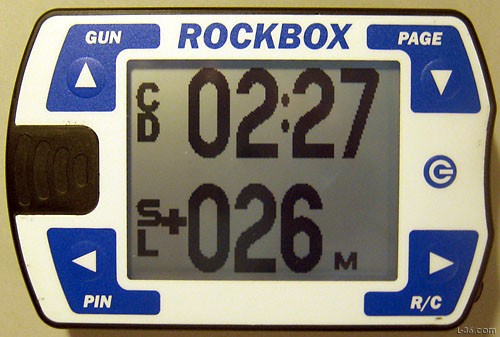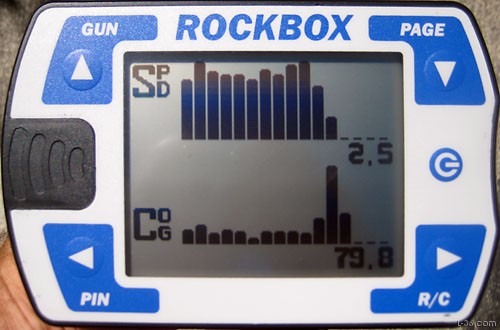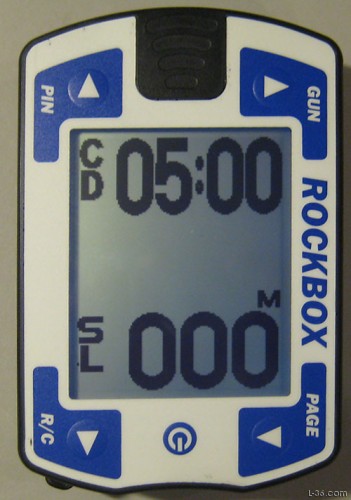Rock Box Review
First Look
It will not come as a surprise to readers of L-36.com that I was a little disappointed to see that there was no "time to line" function (yet) in the new Rock Box Blue. But if you watched any of the Olympics or the America's Cup you see that the vast majority of starts today have boats lining up at a distance from the line and starting their accelerated run seconds before the gun. For those kind of starts, the Rock Box is a perfect match. Having a 50+ year old 12,000 pound boat, I want more than that and the developer of the Rock Box points out that there is more to come on this really solid platform.
That said, the new Rock Box is an impressive product. The waterproof case, O-ring sealed looks solid and well made. There is more to this product than just the start function as I will explain below.
Overview of Rock Box Blue
 |
I wish all the pictures in this article were as good as this one but most have to be taken moving to get anything useful. This is the start screen. It is simple showing basically what the Velocitek Pro Start shows -- Time to the start and Distance to the line. Simple and straight forward. The "Gun" button doubles as the start (long press) and the set (short press) so you can select your start sequence. There is no Sync function but that should not be an issue as it is easy to set it to the next lower minute and get synchronized at the next signal. If you are late on your press of the gun, just long press the gun button again which will stop the countdown and take the unit back up to the higher minute. Another press will decrease the count then a long press at the next gun and you are in business. The distance to the line in in meters with 1 meter resolution. It seems as accurate as one would expect from a differential GPS unit. If anything, it seems a little better behaved. It reads + or - depending on which side of the line you are on. It was nice to see that it would read either side in case you ping the line backward. As many of my races have the R/C on the left, this is a distinct possibility. |
 |
The course over ground and speed over ground page has arrows to show if your speed is increasing or decreasing. This is a nice trimming feature. The readouts are 1 1/4 inch high and are easily read in both bright daylight and at night due to the built in backlight. This is a huge advantage over a tablet based application such as the one I am writing. A tablet of phone is basically unusable in daylight in the cockpit. You have to mount them in the cabin and look through the hatch to see them. With this unit, even with the bright sunlit reflective white surface in bright sun, it was no problem seeing the display. At night, the gentle backlight also made it easy to see without being too bright. |
 |
I must admit to ignorance when it comes to racing in conditions that have periodic shifts where you track on wind shifts. SF Bay just doesn't do that very often. A friend, two time national champion Express-37 tactician, says he has seen conditions like that once in all the years he has been racing. The wind shift screen presents a nice graphical readout of your heading relative to the heading you have been on. That will show you wind shifts and if you want to tack on them, go for it |
 |
The graph page shows a bar graph of your speed and direction so you can see trends. A new bar appears about every 7 seconds with the latest on the left. There is a readout of the scale on the right. The graph is auto scaling, a nice touch. |
 |
The VMG page shows your VMG to wind (you enter the wind direction) and your course over ground. This can be very handy for determining your targets. I question using them in a race, but having a tool like this for practice to determine your targets sure beats the method I have written about. A nice feature. For more than you want to know about VMG to Wind and targets see THIS. |
 |
The waterproof o-ring sealed remote is very nice. I wish I had one for my tablet app. At this point, only the page button functions. In using the remote, I found it took a very hard press to get the button pushed. What a nice change from my remote that crew accidentally presses when fetching their water bottle. The small carabinier supplied solves the "now where is the remote" issue as well. Nicely done. We look forward to having the other buttons implemented. |
 |
This is the back of the Rock Box with the cover off. You can see the red o-ring seal around the circuit board with the batteries on it. The two power wires, red and black, go over the micro SD-card that has the firmware and product manual. The unit comes with an adapter to allow the micro-SD Card to be read like a standard SD Card. There are 4 mounting studs buried in the back of the case and the unit can accept external 12 volt power if it is permanently mounted. The small white circle on the back of the cover is a Gore-Tex vent so that the pressure and temperature can be equalized without allowing water to enter. I need to try that with my GoPro, which otherwise likes to fog up. The circuit board looks like it is very high quality. All in all a very professional looking unit. |
 |
If the Rock Box is vertical when it powers up, it displays in this vertical format. That gives some flexibility to mounting choices. The numbers are 1 1/4 inches in this format. It should also be noted that in vertical mode some of the screens have three lines instead of two. Race start sill has time and distance. The next screen has COG, VMG, and SPD. The wind shift page as the wind shift graph plus the speed histogram and the speed. Next is a page with Speed and COG histograms alnong with a COG readout. I should point out that the histograms do not have scale information as the do in horizontal mode. The final page has VMG readout and histogram and a COG readout. |
Accuracy
Everything I tested check out as very accurate. That said, with any GPS device, it takes a fair amount of time to get a good lock on the satellites. My Qstarz takes 7 minutes to acquire differential GPS mode. Before that you are just not accurate. There is no readout of GPS accuracy on the Rock Box but when I race with it, I am going to leave it on for at least a half hour before the race. Just don't turn it on and ping the line immediately after it gets satellint acquisition and expect to get good results. It acquires quickly but no GPS that I know of is accurate enough for a start when it first locks. It takes time but given the time any GPS needs it looks very accurate.
My testing showed accuracy of about 4 meters peak over time. This is very consistent with every other WAAS enabled GPS unit I have tested and I think it is all one can expect from a GPS unit. Give it some time to lock on all the satellites. I have found this to be true of all GPS units, not just the Rock Box.
My testing so far has just been on the street. I understand that there are tricks in the GPS algorithms to deal with things like waves and other real world racing conditions so I expect this to be more accurate in use than other units. This will have to wait until my race testing next week but my overall impression of the accuracy of the Rock Box Blue is favorable. Distances were well calibrated, speeds and direction compared favorable to the direction my local street shows on a chart and showing true headings. Speed also agreed with both my app and the Toyota speedometer.
In summary, this unit seems accurate, and well calibrated.
Bottom Line
The Rock Box is a well made and accurate product. The various pages are each useful for a different aspect of racing. The unit does scream out for more features and it is clearly in the plans of Rock City Marine to add to the platform over time. The only negative "nit" I found was that a short press of the power button will shut the unit down NOW. At that point all your line ping data is gone. How about a long press for the power button? Other than that the unit does what is says it does and does it well. I look forward to racing with it next week.
Response and Update from Rock City Marine
Regarding the power button, its run through a specialized IC that delays the shutdown when pressed to allow any writes to the SD card to finish, but also completely shuts off current to the circuit board when its off. This was chosen to avoid any issues with corrosion from even the small amount of current it takes to monitor the button with the main processor. It also prevents the batteries from slowly being drained by an active button circuit.
Like you said, the down side is that the starting line marks are lost if it is bumped. To make up for this, we are going to save the marks to static memory in the next firmware upgrade. So if it is shut down, you can restart it and not have to set the marks again. T
There are a lot of features that we are planning for future firmware upgrades, the current firmware is just the start:
Waypoints
distance and bearing to waypoint
VMG based on waypoint
Layline calculation
Project a waypoint based on distance and heading
Auto page change after the start
Auto page change based on upwind or downwind course (VMG heading set to wind heading)
wind heading based on 2 close hauled tacks
Magnetic compass option (working on calibration)
Commander PC/Mac software
Customize page layouts
Adjust settings (damping, histogram time, etc...)
Convert data logs to different formats (gpx, klm...)
NOTICE: Some pages have affiliate links to Amazon. As an Amazon Associate, I earn from qualifying purchases. Please read website Cookie, Privacy, and Disclamers by clicking HERE. To contact me click HERE. For my YouTube page click HERE